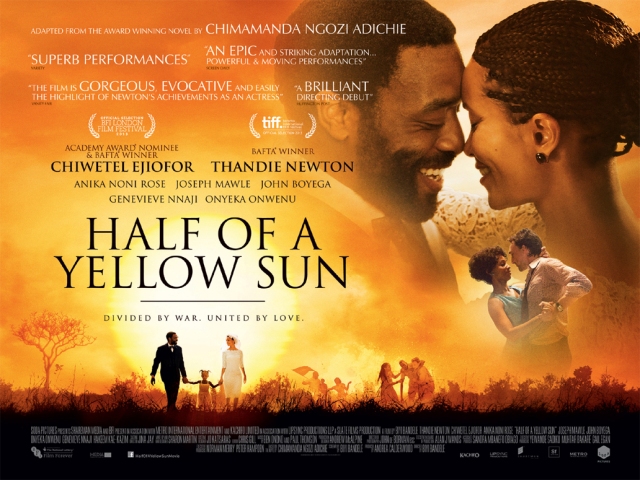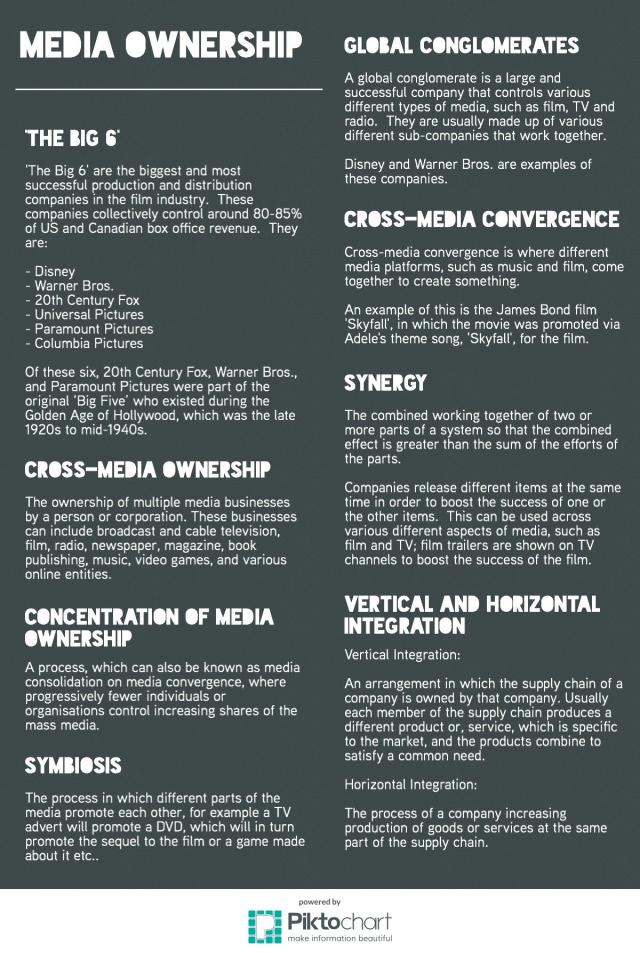Based on the ‘New Technologies’ question from the June 2014 Media Studies exam.
‘The increase in hardware and content in media industries has been significant in recent years.’
Discuss the effect this has had on institutions and audiences of films.
Plan
Introduction
– technology has changed massively over times, especially in the last 100 times
– in this time media has also changed in all areas
– technology used in media, in all areas (production, post-production, marketing, distribution) has changed – the media industry has adapted to change
– more films are actually made because its easier to
Main Body
Case Studies:
Prometheus
Production-
– filmed on digital cameras
– filmed on 3D cameras
Marketing techniques-
– social media marketing- stills, trailers and websites advertised
– websites – projectprometheus.com, weylandindustries.com – games, videos (the viral videos), trailers and stills, exclusive content available
– exclusive content available via text messages – WonderCon business card
– viral videos – 5 videos introducing the characters and the world in which the film is set
Release-
– Conventional theatrical release, then on DVD/Blu-Ray and VOD
Spectre
Production-
– filmed on digital cameras
– filmed on 3D cameras
Marketing techniques-
– websites- offical film website,stills and trailers available
– social media marketing – trailers advertised
– product placement and product commercials – Sony phone commercial – Heineken beer commercial
– Comic Relief sketch – mockumentary of behind the scenes of the film
Release –
– Conventional theatrical release, then on DVD/Blu-Ray and VOD
A Field In England
Production-
– filmed on digital cameras
Marketing techniques-
– social media marketing – Ben Wheatley used Twitter and other social media accounts to market his film – trailers etc.
Release-
– day-and-date release
– freeview TV
– released on Film4
– virtually everyone has a TV at home
– VOD
Special Correspondents
Production-
– filmed on digital cameras
Marketing techniques-
– social media marketing – Gervais released the first trailer on Twitter
Release –
– day-and-date release
– VOD (Netflix)
Essay
Over time technology has changed drastically, especially in the last 100 years, with the invention and discovery of many various different technologies designed for thousands of purposes. In this time media has also changed and increased, in all aspects and areas, as has the technology used in the media industry. In terms of film making the technology used in all areas, such as production, post-production, marketing and distribution, has changed and improved to make the process better, quicker and easier. Due to these new technologies there are more films that are actually produced because it is now much easier to make them. The creation of technologies and devices, such as smartphones, tablets, computers and even game consoles, allow more ways for films to be distributed and marketed due to their ability to store and play content as well as their internet capabilities allowing access to social media sites and VOD platforms.
General film hardware and technology has changed drastically in recent years. Things are now filmed digitally instead of on celluloid film and they’re also distributed, stored and projected digitally. Almost every film made now are filmed on digital cameras, apart from a few choice directors who stick with the old ways, however even films that are produced on actual film are still converted to digital and shown in cinemas on digital projectors. We have seen the rise of effects such as 3D, with films such as Ridley Scott’s sci-fi horror Prometheus (2012) being filmed on both normal and 3D digital cameras. This is also true of Sam Mendes’ most recent James Bond film, Spectre (2015), which was shown in 647 cinemas, and had an opening weekend gross profit of £41.7 million ($63.8 million). Both 4D and IMAX screenings have seen a rise, with seats that move and a make the viewer feel as if they were in the film. Both Prometheus and Spectre was not only shown in normal 2D and 3D but also in various IMAX cinemas in the UK, with Spectre being shown in 40 IMAX screens.
The hardware on which films are released to the public has also changed. In the past one would have to either see a film upon its theatrical release at the cinema or wait until it was released years later on television; some film would also be released on VHS after the creation of the VHS player and then eventually DVD when DVD players were invented. However, the abundance of DVDs has now increased, with most people owning one, along with televisions, and with the creation of the Blu-Ray disc and player there are even more ways of viewing films. Game consoles have also now been designed with disc drives that are capable of playing Blu-Ray and DVD discs, and the abundance of these in the homes of the general public have increased within the last 10 years. Set top boxes have also been created and become very common in the last few years, giving the owner access to VOD providers, such as the Amazon Fire Stick and Apple TV. Freeview boxes such as those provided by Virgin Media and Sky, which again have increased in abundance within the last 10 years, also give the owner access to VOD platforms, such as Netflix. Most film companies utilise DVD/Blu-Ray and VOD platforms for releasing their content after the course of the film’s theatrical distribution. However, some films, such as Ricky Gervais’ Special Correspondents (2016), use only VOD platforms for their release. Gervais’ film was released via a day-and-date method using only the Netflix VOD platform, which is probably the most popular VOD platform; Gervais exploited the fact that the majority of the general public have access to either set top boxes, freeview boxes or mobile hardware such as smartphones, tablets and laptop computers which have internet capabilities and access to VOD providers. This is similar to the release of Ben Wheatley’s A Field In England (2013), which again was released in the UK via a day-and-date method in 17 select Picturehouse cinemas as well as TVOD providers, such as iTunes, Amazon and Film4OD, and the Film4 freeview television channel. Wheatley, like Gervais, was exploiting the fact that most people now own devices with access to the internet as well as nearly everyone owning at least one television.
The creation of new hardware means that there are now more ways than ever before for companies to to distribute their films and products. A market emerged for institutions with mobile hardware, such as smartphones and tablets which are capable of playing content. This is also true of computers and laptops. The portable nature of smartphones, tablets and laptops also mean that users can download content and watch it on the go.
The creation of internet capable devices such as this mean that people now have easy access to social media sites, another market which companies have been able to exploit, mainly in terms of their marketing strategy. More and more films are being marketed and advertised on social media sites such as Facebook and Twitter, which is true of both Prometheus and Spectre. Ridley Scott and 20th Century Fox hired RSA, a promotion company, to market and promote Prometheus. They used guerrilla marketing techniques and utilised the internet and social media heavily. Posters, trailers and stills of the film were shown on social media sites, as well as on websites (projectprometheus.com and weylandindustries.com) created especially for the film. These websites also provided games for the user and showed the viral videos which were created for the film’s promotion, introducing the characters and world of the film; these were also shown on social media. RSA also exploited the increasing use of mobile phones by the public by allowing access to exclusive content for the user by texting a number provided on a futuristic Weyland Industries business card given out at the 2012 Wondercon. This symbiosis was also used with Spectre, which was was promoted on social media sites with trailers and posters, as well as a specially designed website purely for the film. Columbia also exploited the public’s use of televisions, creating partnerships with companies such as Sony and Heineken to create television adverts to promote their product which included cast members of Spectre; this synergy in turn promoted the film.
A Field In England was also marketed heavily on social media, using an active use of Ben Wheatley’s Twitter account with 200,000 followers. This included re-tweeting and commenting on audience tweets and reviews about the film, as well as releasing trailers. The same was true of Special Correspondents, for which the first trailer was released on Ricky Gervais’ Twitter account.
Due to new technologies and hardware there are now more films being made than ever before because of the ease and speed in which they can be produced. Both Prometheus and Spectre are examples of tentpole releases produced by members of the ‘Big Six’ global conglomerates, which were shown in the majority of cinemas across the UK. The fact that they were made by members of the ‘Six’ meant that they could have large production budgets, with Prometheus having a budget of $130,000,000, and Spectre one of $245,000,000. This ease in which films can now be made due to digital technology and hardware means that wealthy companies such as the ‘Big Six’ can make multiple movies a year, and because of this they are filling the cinemas with their products; this blocks out smaller companies and means films made by independent companies or directors with small budgets are less likely to have a large scale theatrical release. Companies which once only showed films are now actually making their own content; these Netflix, which has made television series such as Daredevil and Jessica Jones, as well as films such as Special Correspondents, and HBO, which makes hit series such as Game of Thrones and True Detective.
There are now more films in the cinema and more choice of content than ever before because there is more of everything being made due to the creation of new and digital film making hardware; however, this means that people are less likely to watch a particular film because of the abundance in choice. There is now much easier access to content than ever before, meaning that it can be viewed pretty much wherever, whenever by whoever. This is all because of the creation and abundance of new hardware which gives the user access to the internet, on which they can stream content, download and view content, view it on VOD platforms, and use social media to view promotion of content, meaning they can get excited about are then more likely to view it at the cinema upon its theatrical release.






